WHAT'S NEW ACROSS THE WORLD
Select date in side bar to go a What's
New of previous issues
| What's New ©by
Laif DeMason
This year’s winter season has definitely come
in like a lion! In the United States, record cold, heavy snowfall,
and ice storms have caused many aquarists concern. Power losses associated
with icing can potentially lead to high loses of our fishy pets. Those
who have several large aquariums would do right to look into buying an
adequate portable generator. Generally a 4000 to 5000 watt generator
will be powerful enough and cost a few hundred dollars, certainly less
than replacing your fish. I suggest that you add up your electric usage
by total watts for each heater, filter motor, air pump, and a few lights.
The running wattage should be listed on each device. You will also need
a heavy duty extension cord and always remember to run the generator outside
for safety reasons! Also never feed your fishes during the loss of power;
most fish over one inch can survive without food for a week or longer.
Here’s “what’s new” on the cichlid scene: |
Lake Tanganyika
Collecting of wild caught cichlids continues from most points around
the lake. Exports have slowed somewhat due to large inventories in
most import countries. The world economic slow down could be the
reason for some of the backlog. Current demand in America still seems
to be adult Tropheus, Altolamprologus, and Cyphotilapia varieties.
|
what's new: Lake Tanganyika
|
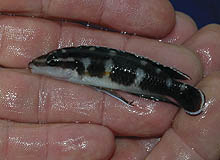
Due to recent efforts to collect wild material from
the northern Congo coastline, some of the special species from that area
have re-appeared. Here Julidochromis transcriptus “Kissi”
is not found elsewhere in the lake. |
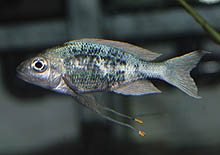
From Nsumbu, Zambia, a male Opthalmotilapia ventralis
is in full breeding dress. Males of this species have different colors
from each location along the southern end of the lake. Thus many varieties
of O. ventralis are sold. |

Another fish sold by location variety is Cyathopharynx
foae. Because wild collected individuals often lack color and are pricey,
it is best to buy bred juveniles and grow them. Often bred males will color
up quite well in a year. Here C. foae from Kapampa, Congo, is one
of the lesser seen types. Photo by A. Konings. |

A rarity not usually seen as a wild fish, Trematocara
variabile is now occasionally bred by specialty breeders. This unique
fish is not strongly colored and is a bit delicate by Tanganyika cichlid
standards. Photo by A. Konings. |
Lake Malawi
Exporters from Lake Malawi are somewhat concerned with the world wide
economic woes. Still, collection and shipments continue. Most exporters
here are in the position where they can manage a bit of belt tightening
for some time. Fish farms in Florida, however, have lost fishes to extreme
cold weather and have spotty shortages in some sizes and species of Malawi
cichlids.

Several Lethrinops species are seasonally and
infrequently collected, piquing interest in some Malawi connoisseurs. Pictured
here is a male L. albus. Forms of this fish are exported from both
Malawi and Tanzania. |

Special order collections are now being accommodated
more often by Lake Malawi exporters. Labidochromis maculicauda from
Puulu, Tanzania is a recent example that would have normally been skipped
over by fish divers. |

Several rare or hard to find cichlids have found their
way into the trade. Here Lethrinops sp. ‘longipinnis deep’ is almost
never seen on Malawi exporters’ lists, but can be found from German specialty
breeders. |
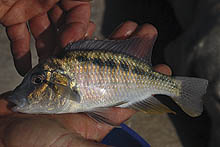
A jumbo Mylochromis species collected from
Itungi Port in Tanzania has recently arrived in small numbers. This large
(by Mylochromis standards) unknown species was not colored, but
has green highlights and a yellow anal fin. |

Occasionally seen on exporters’ lists, Copadichromis
pleurostigma can be collected seasonally. These open water species
can also be found as juveniles from specialty breeders. |

Several of the Tropheops species from Lake
Malawi are not generally traded due to their aggressive nature. However,
in the never-ending challenge to keep new and different varieties, many
of these types have found their ways into importers’ tanks recently. Here
T. sp. ‘sand’ was collected from Undu Point, Tanzania. Photo by
A. Konings. |
Lake Victoria
Not much news to report for the Victorian basin cichlids. No news of
any wild commercial collections, although the interest in these fishes
is still good. Most hobbyists can only rely on material from bred sources.
|
what's new: Lake Victoria
|

Originally from the Kenyan area of Lake Victoria,
Haplochromis sp. salmon Hippo Point has been offered by breeders
for some time. |

Also available from specialty breeders, this Pundamilia
nyererei strain was originally collected from Ruti Island, Tanzania.
There are similar varieties of P. nyererei also bred from other
locations. Photo by O. Seehausen. |
Neotropics
The popularity and interest in many of the South American species of
tropical fishes has increased over the last few years. While some hobbyists
are interested in a wide range of fishes from this region, like catfish,
there are still those who only keep and breed their own brand of specialty
cichlids.

Collected by avid hobbyists travelling in Uruguay,
Gymnogeophagus gymnogenys is found in many locations, often differing
for each location. Here a beautiful male specimen with a large hump from
the San Borja region. Photo by S. Jack. |

Also from Uruguay, Crenicichla tendybaguassu
is one of the many pike cichlids found in this region. This fish requires
a large aquarium as it grows quite large. Note the large fleshy lips! Photo
by O. Lucanus. |
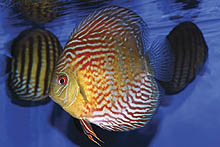
Occasionally, Heckel discus are also collected from
the Amazon River and exported from Brazil. Some wild individuals also sport
strong colors of red or blue, like some of the selectively bred strains.
This wild fish has interesting markings of strong red color. |
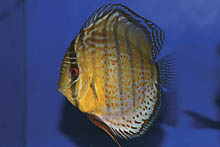
Collected for many years from Lake Tefe, Peru, wild
green discus are frequently being imported. It is interesting that this
beautiful strain is still sought after for so many years! |
Select date in side bar to go a What's
New of previous issues
|















